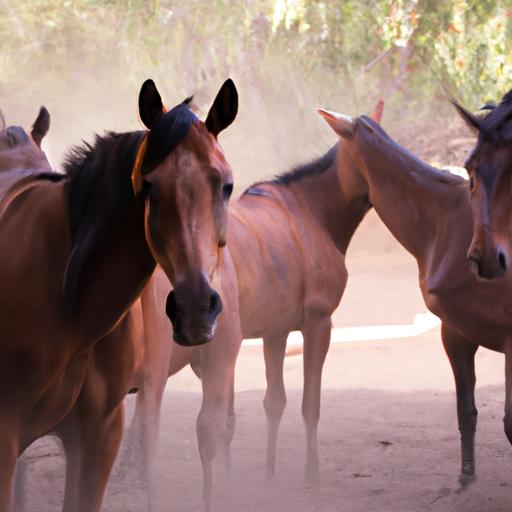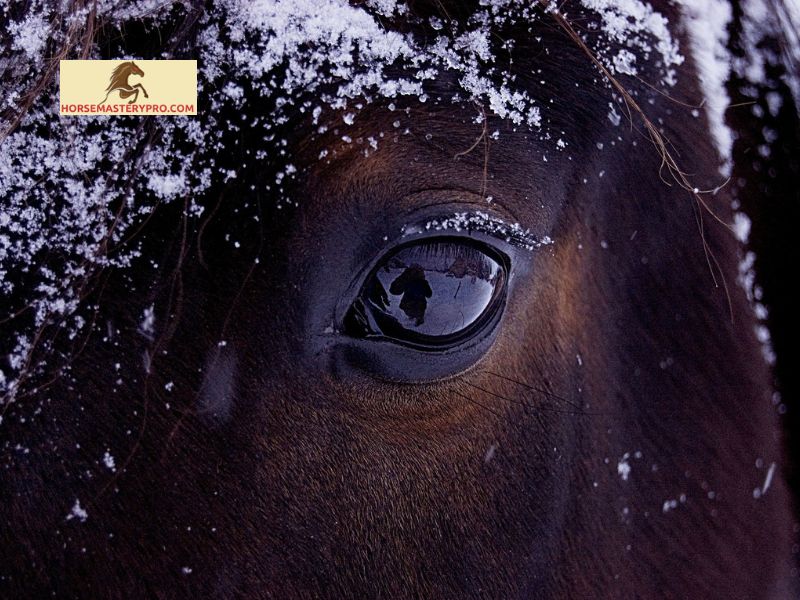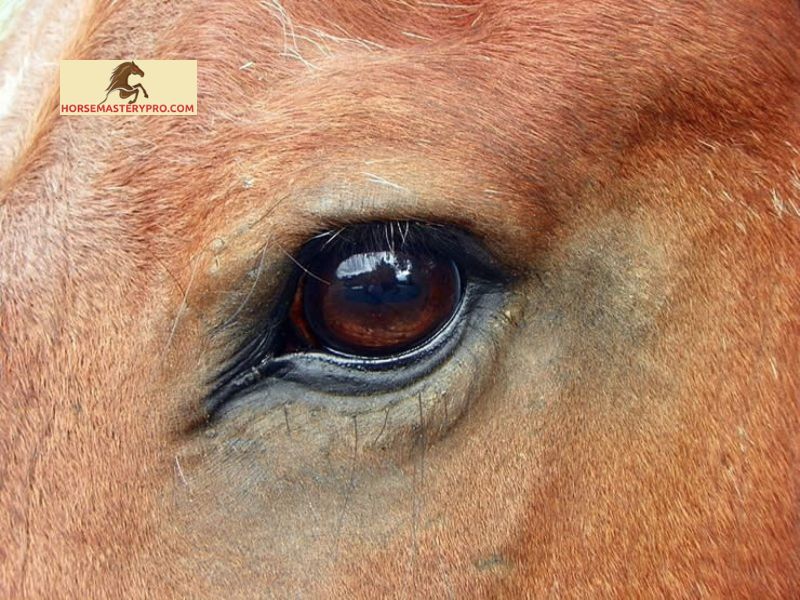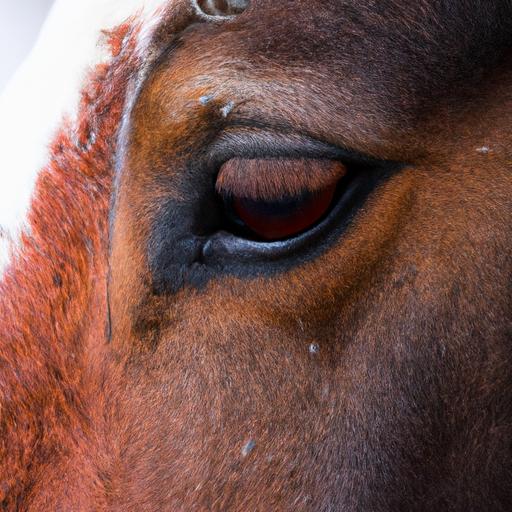Discover effective prevention and control measures for pink eye in horses. Learn about vaccination options, fly control strategies, and hygiene practices. Protect your equine companions.
Have you ever wondered what pink eye in horses really is? Whether you are a seasoned equestrian or a horse enthusiast, understanding and effectively treating pink eye in horses is crucial to ensure the well-being of these magnificent creatures. In this article, we will delve into the world of pink eye in horses, exploring its definition, highlighting its significance, and providing an overview of the article’s content.
A. Definition of Pink Eye in Horses

Pink eye, also known as conjunctivitis, is an ocular condition that affects horses, causing inflammation and irritation in the conjunctiva, the thin membrane that covers the front surface of the eye and lines the inner eyelids. This condition can occur in one or both eyes and is characterized by redness, swelling, excessive tearing, and discharge. It can cause discomfort and distress to the affected horse if left untreated.
B. Importance of Understanding and Treating Pink Eye in Horses
Treating pink eye promptly is essential for several reasons. Firstly, pink eye can be highly contagious among horses, spreading rapidly within a herd. Early identification and treatment can help prevent the further spread of the condition and minimize the risk of an outbreak. Additionally, untreated pink eye can lead to complications such as corneal ulcers, which can result in vision impairment or even permanent damage. Lastly, horses experiencing discomfort from pink eye may exhibit behavioral changes, affecting their overall well-being and performance.
C. Brief Overview of the Article’s Content
Throughout this article, we will explore the various causes of pink eye in horses, including bacterial and viral origins, as well as the influence of environmental factors. We will discuss the common symptoms and diagnostic methods used by veterinarians to identify pink eye in horses. Furthermore, we will delve into the treatment and management options available, including antibiotic and antiviral medications, supportive care, and follow-up visits. We will also highlight prevention and control strategies, such as vaccination, fly control measures and hygiene practices. By the end of this article, you will have a comprehensive understanding of pink eye in horses, empowering you to take proactive measures to protect your equine companions.
Stay tuned for the next section, where we will explore the causes of pink eye in horses in more detail. Remember, understanding the root causes is key to effectively managing and preventing this ocular condition.
Causes of Pink Eye in Horses

Pink eye in horses can be attributed to various causes, including bacterial infections, viral agents, and environmental factors. Understanding these underlying causes is crucial in implementing effective prevention and treatment strategies. Let’s explore each cause in detail:
A. Bacterial Causes
- Specific Bacteria Responsible for Pink Eye in Horses
Several bacterial species can lead to pink eye in horses, with Moraxella spp. being the most common culprit. Other bacteria, such as Streptococcus equi, Staphylococcus spp., and Haemophilus spp., can also contribute to the development of this ocular condition.
- Transmission Methods
Bacterial pink eye in horses is often transmitted through direct contact with infected animals or contaminated objects. Flies and other insects can act as carriers, transferring the bacteria from one horse to another. Additionally, unsanitary conditions, such as shared water troughs or dirty stables, can facilitate the spread of bacteria.
B. Viral Causes
- Common Viruses Associated with Pink Eye in Horses
Viral agents can also trigger pink eye in horses. Equine herpesvirus (EHV), specifically Equine Herpesvirus-2 (EHV-2) and Equine Adenovirus, are commonly associated with viral conjunctivitis. These viruses can cause inflammation and discomfort in the conjunctiva, leading to the characteristic symptoms of pink eye.
- Modes of Transmission
Pink eye caused by viruses can spread through direct contact with infected horses or through respiratory secretions. Shared equipment, such as water buckets or grooming tools, can also serve as potential sources of viral transmission.
C. Environmental Factors
- Influence of Dust, Flies, and Other Irritants
Dust, pollen, and other airborne irritants can contribute to the development of pink eye in horses. These particles can irritate the sensitive conjunctiva, leading to inflammation and discomfort. Flies, in particular, can aggravate the condition by carrying bacteria or contributing to the spread of viral agents.
- Impact of Overcrowding and Unsanitary Conditions
Overcrowding horses in confined spaces or unsanitary environments can increase the risk of pink eye. Poor ventilation, inadequate waste management, and lack of cleanliness create conditions that are conducive to the growth and spread of bacteria and viruses.
Understanding the various causes of pink eye in horses enables us to implement targeted measures to prevent and manage this ocular condition. In the next section, we will explore the symptoms and diagnosis of pink eye, empowering you to recognize and address this issue promptly.
Symptoms and Diagnosis

When it comes to pink eye in horses, recognizing the symptoms and obtaining a proper diagnosis are crucial steps towards effective treatment. In this section, we will explore the visible signs of pink eye, the behavioral changes that horses may exhibit, and the veterinary diagnosis process.
A. Visible Signs of Pink Eye in Horses
One of the most apparent signs of pink eye in horses is the redness and swelling of the affected eye. The conjunctiva, the thin membrane covering the eye, becomes inflamed, giving the eye a pink or reddish appearance. Additionally, horses with pink eye often experience excessive tearing and discharge from the affected eye. This discharge may range from clear and watery to thick and yellowish, depending on the severity of the condition.
B. Behavioral Changes and Discomfort
In addition to visible signs, horses with pink eye may exhibit behavioral changes indicative of discomfort. They may squint or rub the affected eye frequently, attempting to alleviate the irritation. Moreover, horses suffering from pink eye may display sensitivity to light, avoiding bright environments or seeking shade to alleviate their discomfort.
C. Veterinary Diagnosis Process
To confirm a diagnosis of pink eye in horses, veterinarians employ a thorough diagnosis process. This typically begins with a physical examination of the horse’s eye, assessing the severity of inflammation, redness, and discharge. In some cases, veterinarians may also perform laboratory tests and collect samples from the eye to identify the causative agent, whether it be bacteria or a virus.
By closely observing the visible signs, recognizing behavioral changes, and seeking professional veterinary guidance, you can ensure an accurate diagnosis of pink eye in your horses. In the next section, we will explore the various treatment and management options available to alleviate the discomfort caused by this ocular condition. Stay tuned!
Treatment and Management
When it comes to treating pink eye in horses, a combination of methods is often employed to alleviate symptoms and promote healing. In this section, we will explore the different approaches to treatment and management, ensuring the well-being of your equine companion.
A. Antibiotic and Antiviral Treatment
- Medications commonly prescribed for pink eye in horses
- Antibiotics: Veterinarians may prescribe topical or systemic antibiotics to combat bacterial infections associated with pink eye. Commonly used antibiotics include tetracycline, erythromycin, and gentamicin.
- Antivirals: In cases where the pink eye is caused by a viral infection, antiviral medications like idoxuridine or trifluridine may be recommended. These medications can help inhibit viral replication and reduce symptoms.
- Proper administration techniques
- Topical application: Eye drops or ointments are typically applied directly to the affected eye. It is crucial to follow the veterinarian’s instructions regarding the frequency and duration of medication administration.
- Systemic treatment: In some severe cases or when the infection has spread beyond the eye, oral or injectable medication may be prescribed. It is essential to administer these medications as directed to ensure optimal absorption and effectiveness.
B. Supportive Care and Management Practices
- Isolation and quarantine measures
- Isolate the infected horse: To prevent the further spread of pink eye within a herd, affected horses should be isolated from healthy individuals. This helps minimize direct contact and potential transmission of the infection.
- Quarantine protocol: Implementing a quarantine period for infected horses can ensure that the condition is contained and does not affect other animals on the premises. Consult with your veterinarian regarding the appropriate duration and guidelines for quarantine.
- Creating a clean and fly-free environment
- Cleanliness is key: Regularly clean and disinfect stables, equipment, and water troughs to minimize the presence of bacteria and viruses. This helps create a healthier environment for your horses and reduces the risk of reinfection.
- Fly control: Flies can worsen the symptoms of pink eye and contribute to its spread. Implement effective fly control measures such as fly masks, fly sheets, fly traps, and insecticide sprays to protect your horses from irritating flies.
C. Follow-Up Visits and Monitoring Progress
- Importance of regular check-ups
- Schedule veterinary visits: Regular follow-up visits are crucial to monitor the progress of the treatment and ensure the condition is improving. Your veterinarian will assess the healing process and make any necessary adjustments to the treatment plan.
- Address any concerns: During these visits, discuss any concerns or changes in your horse’s condition with the veterinarian. They can provide guidance and advice on how to best support your horse’s recovery.
- Evaluating treatment effectiveness
- Observe symptoms: Continuously monitor the symptoms of pink eye in your horse. Look for improvements such as reduced redness, swelling, discharge, and discomfort. If the symptoms persist or worsen, inform your veterinarian immediately for further evaluation and potential adjustments to the treatment plan.
In the next section, we will explore prevention and control strategies to help safeguard your horses from pink eye. Remember, a comprehensive approach to treatment and management is crucial for a successful recovery.
Conclusion
In conclusion, understanding and effectively managing pink eye in horses is crucial for their overall well-being and the prevention of widespread outbreaks. Pink eye, or conjunctivitis, can cause discomfort and distress to horses if left untreated, potentially leading to vision impairment and complications. By promptly identifying and treating pink eye, we can minimize its spread and ensure the best possible outcome for our equine companions.
Throughout this article, we have explored the definition of pink eye in horses and emphasized the importance of understanding and treating this ocular condition. We have discussed the various causes, including bacterial and viral origins, as well as the influence of environmental factors. Additionally, we have delved into the symptoms, diagnosis, treatment, and management options available.
To prevent and control pink eye in horses, vaccination is a crucial aspect. Vaccines specifically designed for preventing pink eye are available, and following proper vaccine administration guidelines is essential for their effectiveness. Furthermore, implementing fly control measures can help minimize fly populations, as flies are known carriers of the condition. Using fly repellents and providing protective gear for horses can also contribute to preventing pink eye.
Maintaining good hygiene and sanitation practices is another key preventive measure. Regularly cleaning equipment and stables, as well as implementing proper waste management techniques, can help reduce the risk of pink eye transmission within a horse’s environment.
At horsemasterypro.com, we prioritize the health and well-being of horses. By being proactive and implementing preventive measures, we can minimize the occurrence and impact of pink eye in our equine companions. Remember, early detection, prompt treatment, and preventive strategies are the keys to keeping our horses happy and healthy.
Thank you for joining me on this journey to understand pink eye in horses. Stay informed, stay vigilant, and let’s work together to ensure the well-being of our beloved horses.


